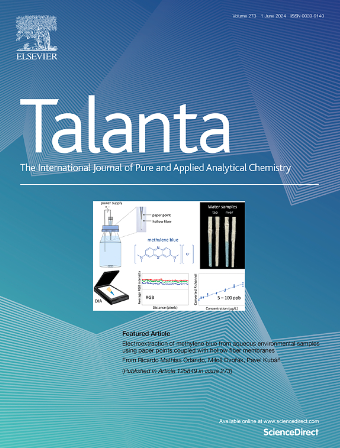AIEgen-based metal-organic gels for rapid and ultrasensitive discrimination of piceatannol from core-isostructural analogues
IF 5.6
1区 化学
Q1 CHEMISTRY, ANALYTICAL
引用次数: 0
Abstract
A highly stable and strongly fluorescent metal-organic gel, Zr-TCBPE-MOG, was successfully synthesized through the combination of aggregation-induced emission luminogens (AIEgens) 1, 1, 2, 2-tetra(4-carboxylbiphenyl) ethylene (H4TCBPE) with Zr (IV) cations. The fluorescence of Zr-TCBPE-MOG exhibits a sensitive response to piceatannol (3,3′,4,5′-tetrahydroxy trans-stilbene, PCT), whereas its structural analogues, such as resveratrol, pterostilbene, rhapontigenin, and pinosylvin, which share the same core skeleton, have no effect on it. Therefore, Zr-TCBPE-MOG can function as a fluorescent probe for rapid differentiation and detection of PCT among these structural analogues. A simple and rapid fluorescence method was established via the selective fluorescence quenching effect of PCT on Zr-TCBPE-MOG through the photoinduced electron transfer effect. Under optimal measurement conditions, the proposed method achieves high sensitivity for PCT with a linear detection concentration range from 3.5 to 250 nM and a low detection limit of 2.8 nM. It also can realize selective determination of PCT in serum samples. This work reveals the great potential of MOG for the rapid and highly specific differentiation of structurally similar drugs.

基于aiegen的金属-有机凝胶用于快速和超灵敏地区分皮杉酚与核心同工结构类似物
通过聚集诱导发光物质(AIEgens) 1,1,2,2 -四(4-羧基联苯)乙烯(H4TCBPE)与Zr (IV)阳离子的结合,成功合成了一种高度稳定、强荧光的金属-有机凝胶Zr- tcbpe - mog。Zr-TCBPE-MOG的荧光对picetanol(3,3 ',4,5 ' -四羟基反式二苯乙烯,PCT)有敏感的响应,而其结构类似物,如白藜藜醇、紫檀二苯乙烯、rhapontigenin和pinosylvin,具有相同的核心骨架,对其没有影响。因此,Zr-TCBPE-MOG可以作为荧光探针在这些结构类似物中快速区分和检测PCT。通过光致电子转移效应,利用PCT对zr - tcpe - mog的选择性荧光猝灭效应,建立了一种简单快速的荧光方法。在最佳测量条件下,该方法对PCT具有较高的灵敏度,线性检测浓度范围为3.5 ~ 250 nM,检出限低至2.8 nM。并可实现血清样品中PCT的选择性测定。这项工作揭示了MOG在结构相似药物的快速和高度特异性分化方面的巨大潜力。
本文章由计算机程序翻译,如有差异,请以英文原文为准。
求助全文
约1分钟内获得全文
求助全文
来源期刊

Talanta
化学-分析化学
CiteScore
12.30
自引率
4.90%
发文量
861
审稿时长
29 days
期刊介绍:
Talanta provides a forum for the publication of original research papers, short communications, and critical reviews in all branches of pure and applied analytical chemistry. Papers are evaluated based on established guidelines, including the fundamental nature of the study, scientific novelty, substantial improvement or advantage over existing technology or methods, and demonstrated analytical applicability. Original research papers on fundamental studies, and on novel sensor and instrumentation developments, are encouraged. Novel or improved applications in areas such as clinical and biological chemistry, environmental analysis, geochemistry, materials science and engineering, and analytical platforms for omics development are welcome.
Analytical performance of methods should be determined, including interference and matrix effects, and methods should be validated by comparison with a standard method, or analysis of a certified reference material. Simple spiking recoveries may not be sufficient. The developed method should especially comprise information on selectivity, sensitivity, detection limits, accuracy, and reliability. However, applying official validation or robustness studies to a routine method or technique does not necessarily constitute novelty. Proper statistical treatment of the data should be provided. Relevant literature should be cited, including related publications by the authors, and authors should discuss how their proposed methodology compares with previously reported methods.
 求助内容:
求助内容: 应助结果提醒方式:
应助结果提醒方式:


